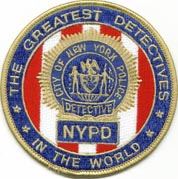
THE WALK OUT: FAREWELL, CHIEF JOSEPH CUNNEEN
Tuesday, December 19, 2006. 1600 hours. 179 Wilson Avenue, Bushwick, Brooklyn North Borough Command.
Gathered on the street were several hundred uniformed and civilian clothed members of the service – gathered to say farewell to a dear friend. A cop’s cop.
Assistant Chief Joseph F.X. Cunneen, after some forty years of service, walked out of the Borough Command to a gathering of friends wishing him good luck upon his retirement. A retirement from the Police Department of the City of New York, a loss to each and every member of this department, none more so than the men and women who police the great area known as Brooklyn North.
Chief Cunneen, who is leaving less than a year shy of his 63rd birthday – and what would have meant mandatory retirement – to take a job leading the Allied-Barton Security firm’s newly-formed government services account.
F X – as he is affectionately known by many – will certainly find time to take off to the golf links, but will certainly be leading a very active “retirement” life in the corporate world of security. Anyone who knows Chief Cunneen has no doubts his continued success will be for the benefit of Allied-Barton and their clients.
But it was on this soon-to-be winter afternoon, as the temperature was dropping, that men and women from all facets of this department gathered for a friend. His years spent in Brooklyn North have not gone unnoticed – and it was patently obvious it had touched many lives and hearts, evidenced by the throng gathered on Wilson Avenue this afternoon.
With bagpipes playing, a solo PD helicopter flying overhead, and a sharp contingent of Highway Patrol motorcycles ready as an escort, Chief Cunneen and his lovely wife and family walked from the Borough Command Office, returning a sharp salute to all those gathered to wish him all the best on his departure from the department.
He then walked through the line of uniforms and civilian-clothed well wishers, stopping to shake each and everyone’s hand along the way, many with a tear in their eye.
There was Paddy Boyle, friends growing up together in the old neighborhood. Kevin Murphy and Kevin Coursey, long time friends from the beach of the Rockaways, gathered as well. Former commanders, retirees, current Chief’s, civilian members – truly every facet, every level, of this vast department was there for Joe. Mike Gabriel, who worked alongside FX for several years, along with Brian Fogarty – his aide, his assistant, his helper and his friend. So many faces – and he walked by each one and stopped to shake their hand, exchange a hug and sometimes a kiss, people who had shared so much together at one time or another.
A crisp smile adorned FX’s face, but all who know him are aware of the emotion he carried, so well, inside him.
Didn’t he look ever so sharp in his uniform? The brisk walk, the twinkle in his eye, the firm handshake of a Chief of Police. A proud Marine, proud leader of police, loved by so many. Didn’t Mrs. Cunneen look great as well? Well dressed in appearance, a smile and twinkle in her face as well. Had not Joe’s forty-some years in the department been shared every step of the way by this magnificent woman as well? They looked great making there way down the assembled line, shaking hands, exchanging hugs and kisses along the way.
Wasn’t it so fitting for Joe Cunneen to turn back and face the crowd as he reached the end of the line, put his hands in the air, and proclaim in that oh-so clear and distinct voice, for all to hear, “BROOKLYN NORTH”!!!
“A cop’s cop”. I heard that more than a few times this afternoon. “A real gentleman” was another common phrase. We can go on and on.
“I learned a lot working for Chief Cunneen”; “He was always fair, what more could you ever ask for in a boss”; “He never forgot what it was like to be a cop”; “I love that man, and we’re all going to miss him”.
From the bottom of all our hearts, we wish you the best of luck in your retirement from this department, and best wishes in your next career. We know you’ll continue to enjoy life, play some golf, and share a lot of good times with your family.
Remember, also, Joseph F.X. Cunneen – we will always remember you as a leader, as a cop, as the caring and hard working person you showed us for so many years.
We love you, we’ll miss you, but we can only be happy in wishing you all of the best that you worked so hard for, and deserve.
Chief Joseph F.X. Cunneen – a cop’s cop, a Marine, a friend.



